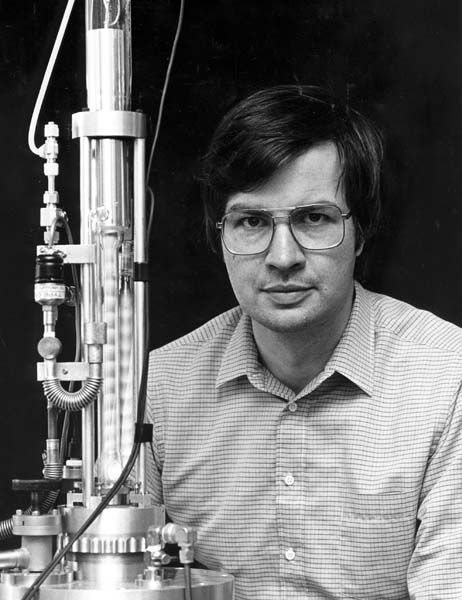Theodor W. Hänsch
Theodor W. Hänsch

Nobel Laureate and Optica Honorary Member Theodor Hänsch was born in Heidelberg, Germany on October 30, 1941. As a young boy Hänsch lived in a house once owned by chemist Robert Bunsen. An experiment set up by Hänsch’s father to explain Bunsen’s contributions to chemistry kindled an early interest in light and atoms in the young Hänsch. As he grew older he eagerly read everything from popular science magazines to science textbooks and ran his own experiments in chemistry, physics, and electronics.
At the University of Heidelberg, Hänsch studied physics and mathematics. After receiving the Vordiplom in 1963, Hänsch worked as an assistant in the laboratory of Hans Kopfermann and became increasingly intrigued by the newly invented laser. When an opportunity arose to study gas lasers at the nearby Institute of Applied Physics at Albert-Überle-Strasse, Hänsch signed on. For his diploma research, Hänsch studied saturation effects in the gas laser medium by observing the light emitted spontaneously to the side. He determined a number of previously unknown radiative transition rates in the neon atom. He received his doctorate in 1969. Much of the early work Hänsch undertook is still cited because it laid the groundwork for the understanding of phenomena such as lasers without inversion, electromagnetically induced transparency, and slow light.
In March 1970, Hänsch left Germany to work with Arthur L. Schawlow at Stanford University as a NATO postdoctoral fellow. Hänsch’s time at Stanford put him directly at the heart of a revolution in laser spectroscopy. He acquired an early commercial nitrogen laser and spent six months experimenting with a range of configurations and applications. Towards the end of 1970, he began to focus his efforts on the goal of making a widely tunable dye laser highly monochromatic.
Other experiments involved ultrasensitive fluorescence spectroscopy enabling detection of light from single atoms, sensitive intracavity absorption spectroscopy with a multimode dye laser, the first demonstration of continuous wave Doppler-fee two-photon spectroscopy, and Doppler-free polarization spectroscopy. The roots of the laser frequency comb can be traced to Hänsch’s years at Stanford.
In 1978, Hänsch went on sabbatical to the University of Munich with an Alexander von Humboldt Senior U.S. Scientist Award. Almost a decade later he accepted an offer to join the Ludwig-Maximilian University in Munich as a professor of experimental physics and to build a new Division of Laser Spectroscopy at the Max-Planck-Institute.
During the 1990s Hänsch’s team focused on the quantum physics of ultracold atoms. His group demonstrated and explored two- and three-dimensional optical lattices bound by light; they explored new tricks for laser cooling below the recoil limit; and in the late 1990s realized Bose-Einstein condensation (BEC) of rubidium atoms in a novel magnetic QUIC trap. They later exploited the high magnetic stability of the small trap in the first continuous wave atom laser. Work on microscopic magnetic traps to manipulate cold paramagnetic atoms led to an effective method for loading cold atoms into microscopic traps, and a working conveyer belt for atoms. In June 2001, Hänsch’s group was the first to achieve Bose-Einstein condensation entirely on a microfabricated atom chip.
In 1985, he received the William F. Meggers Award "for his discoveries of powerful techniques for high-resolution laser spectroscopy, and their application to fundamental problems of physics, particularly through precision measurements on atomic hydrogen."
He along with John L. Hall received half of the Nobel Prize in Physics 2005 "for their contributions to the development of laser-based precision spectroscopy, including the optical frequency comb technique." The other half was awarded to Roy J. Glauber.
Hänsch received many other awards such as the Gottfried Wilhelm Leibniz Prize, IEEE’s I.I. Rabi Award, the Philip Morris Research Prize, and numerous honorary degrees. His many scientific society memberships include the European Academy of Arts and Sciences, Academia Europea, International Raoul Wallenberg Foundation, and the U.S. National Academy of Sciences.
He was awarded the Frederic Ives Medal/Jarus W. Quinn Prize "for seminal contributions and landmark advances in optical science and atomic physics, including narrow-band dye lasers, Doppler-free laser spectroscopy, laser cooling of atomic gases, precision spectroscopy of atomic hydrogen, frequency metrology with optical combs, and new physics with cold atoms in optical lattices." He became a Fellow of OSA in 1975 and an Honorary Member in 2008.
Document Created: 26 July 2023
Last Updated: 03 December 2024
